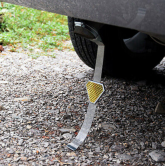The below is my current understanding. It should be understood that I am absolutely not an expert and not fully confident in my understanding of this complex topic, but it should also be understood what I write is based on research I have done, not just conjecture or assumption. I put my understanding out there to hopefully help others learn, and equally important to improve and refine and correct my own understanding, with that in mind, if something isn't clear or if something seems wrong to you, bring it up, and if possible provide a reference or an explanation. I lean heavily on bits and pieces I have learned from Samlex, Magnum, Mike Holt, RSD Academy, the ABYC, and Victron. I am certain, I do not have a full and adequate understanding of grounding theory yet.
Isn't it because in a vehicle there is no path to ground due to the fact the vehicle sits on rubber tires?
Setting aside lightning,
My understanding is that chassis-ground (assuming isolated mobile system--no shorepower) is a conceptual stand-in for earth-ground in many important respects. In that it is (1) a massive common "0V" reference (2) a common low resistance return path for fault current.
Victron explains chassis ground as being conceptually like a "local earth ground"
The principle should be the same I think, or even more important with a less massive chassis (compared to the mass of the earth). My understanding is that their is nothing special about the physical earth as 'earth-ground' beyond that it is far and away the best option we have. But the concept, a massive "0V" common reference and universal common return path can be applied on smaller isolated scales and in other contexts.
Similar to how your house bank gets tied to chassis-ground in a vehicle, equalizing potential between B- and the vehicle Chassis, and creating a common fault path for current to flow back to the source (the battery), On a larger scale, the actual earth is serving the same purpose as the chassis, it works in the same way. The power grid and the original voltage source (power plant) are also tied to earth ground, in that respect the physical earth is a path back to the source.
So in the case of an isolated system like a vehicle (ignoring shorepower) where the voltage source is a battery (or alternator or PV panels or whatever), The chassis serves the same purposes as the earth in a grid tied system (common 0V reference, common fault current return path connected to the voltage source).
But I am confused by something. Most of the inverters I have looked at that are greater than 1000 watts have a separate connection to go to DC ground. I am confused why the manufacturers even have this connection since the ground cable of the inverter goes to DC negative on the battery which is the same as DC ground. I would really appreciate an answer to this.
For me it was useful to learn about the two distinct but connected grounding concepts (I'm not sure what your level of understanding here is, you may already understand this), "Equipment grounding" and "System Grounding."
System grounding is the concept of physically and electrically bonding one side of your electrical system to the designated grounding point (chassis or earth-ground rod usually). This is what "grounds" your electrical system. In a vehicle based system, this is commonly done off the negative busbar, or battery negative terminal.
Equipment grounding is the concept of bonding the exposed metal parts of your components back to the grounding busbar, negative busbar, or designated system grounding point.
These Equipment Grounding Conductors (EGC) should not normally carry current, but they are a low resistance return path if there is a short that energizes the metal casing of a component. The important of this is threefold, (1) because its a low resistance path, it should hopefully allow enough current to flow that your breaker or fuse trips and de-energizes the faulty circuit and alert you to the problem, (2) its a much lower resistance return path than you might be, so you are unlikely to become the return path if you touch the wrong two things, (3) it decreases the chances of a fire for the same reasons as point 2.
The important takeaway is that the primary purpose of an EGC, is a low resistance fault path back to the source.
There is more complexity with inverter/chargers in a mobile/marine context if shorepower is involved. Explaining this is beyond the scope of this conversation, the term you want to research is "Neutral-Ground bonding" or "Neutral-Ground switching" and the broad idea is that AC neutral and ground should only be connected at one point in the system. Where that point is depends on the power source, since a mobile system will have different power sources (battery, shorepower/grid, generator, etc) the point at which Neutral and Ground should be bonded changes based on context. An inverter charger designed for mobile/marine applications (UL 458) will handle this internally. When in 'inverting mode' I believe neutral is bonded to the inverter chassis.




